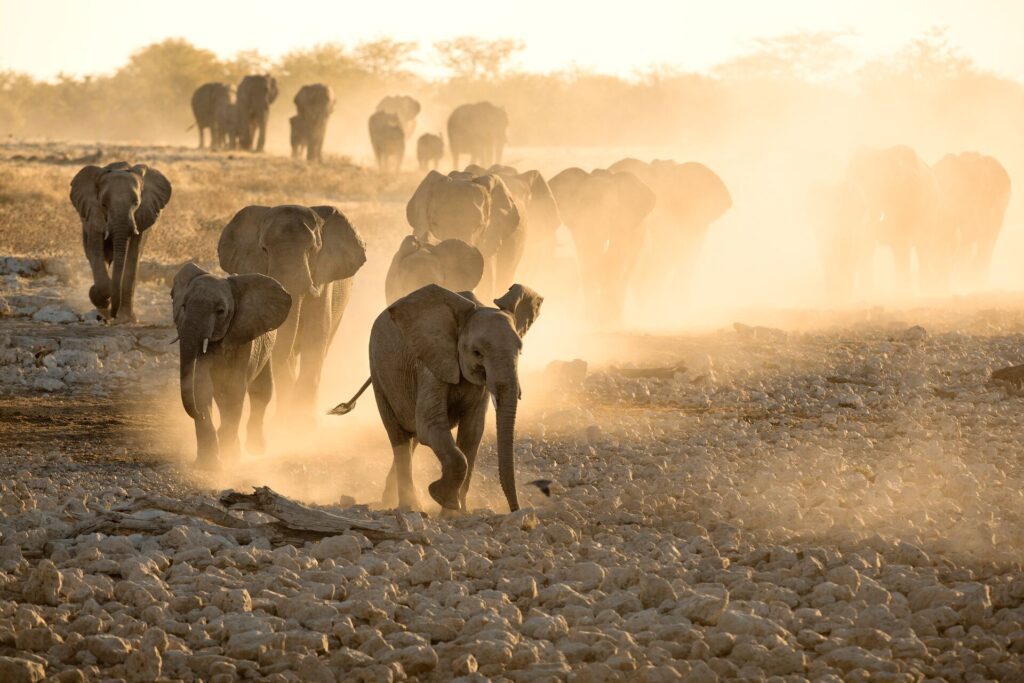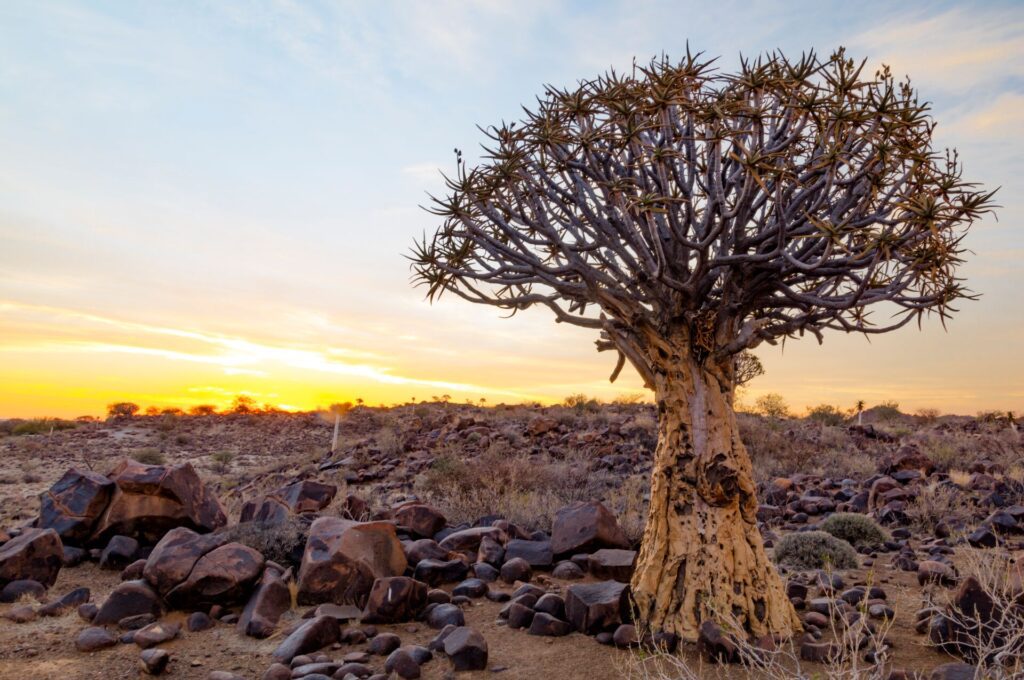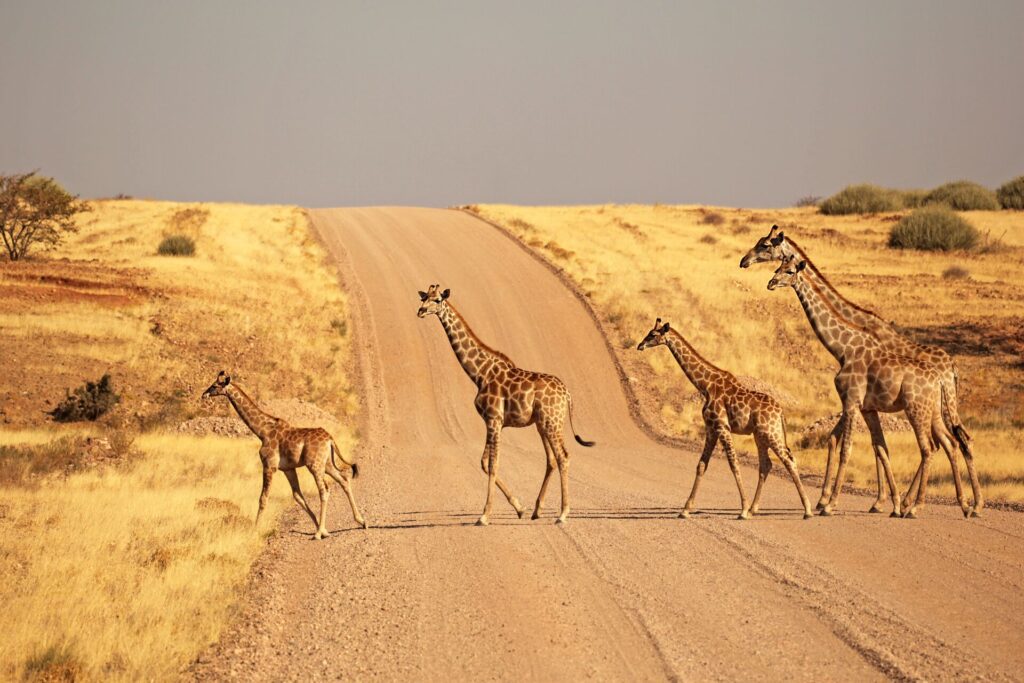Wedged between Angola, Botswana, Zambia and South Africa in the continent’s southwest, Namibia’s landscapes are as diverse as the menagerie that fills them. Here, red deserts, desolate coastlines, lush floodplains and vast salt pans all set the scene for encounters with more than 5,200 species of flora and fauna, many of them endemic (get your bearings with this handy map).
Whether you’re into classic African guided safaris or taking your own sweet time on a self-drive holiday, discovering the wildlife of Namibia is an opportunity to MAKE TRAVEL MATTER® – and to have the wildest adventure of your life. Read on to discover Namibia’s most sought-after critters and where to see them for yourself.
Quick Overview of Namibia’s Ecosystems
At a glance, Namibia spans four terrestrial biomes – desert, karoo, savannah and woodland – plus two aquatic realms: the Atlantic coast/marine zone and extensive wetlands. Each ecosystem brings new wildlife opportunities: fleet-footed oryx (gemsbok) on the towering dunes of Sossusvlei and the Namib Desert; lions, giraffes, zebras and rhinos gathering at Etosha National Park’s waterholes; and desert-adapted elephants amid the rugged expanses of Damaraland and Kaokoland. Watery wildernesses are a stark contrast to these parched lands: along the Skeleton Coast you’ll find Cape fur seal colonies, and in the country’s northeast, the hippo-dotted wetlands of the Zambezi Region (also known as the Caprivi Strip). It all adds up to a nationwide tapestry of habitats sustaining a unique mix of life.


Common Mammals Found on Safari
Namibia’s four-legged residents extend well beyond the Big Five – yes, you should look for lions, leopards, elephants, rhinos and buffaloes, but the real magic of the wildlife of Namibia lies in its sheer variety.
Oryx (gemsbok)
Iconic on the Sossusvlei dunes and widespread across Namib-Naukluft and Etosha, the gemsbok thrives in arid zones by going long stretches without drinking and drawing moisture from desert plants. And while some may quip about ‘desert unicorns’, oryxes actually have two long horns – often up to about 120cm, and more than capable of deterring predators.
Springbok
Small, agile and abundant on Etosha’s plains and other open semi-arid habitats, springboks pile around waterholes in large numbers. When threats appear from lions, cheetahs and other predators, they ‘pronk’: a stiff-legged, springing high bounce that confuses their would-be hunters.
Greater kudu
Greater kudu are browsers, not grazers, and their spiral horns make them easy to pick out in broken woodland – especially in mopane and acacia belts around Etosha, and in the northeast around Waterberg Plateau, where they live alongside fellow browsers like roan and sable.


Elephant
Namibia is home to some 23,000 savannah elephants, and you’ll find them in big herds at Etosha’s waterholes and in the Zambezi Region. Further afield, the famed desert-adapted elephants of Damaraland/Kaokoland can go days without water while travelling between sources and are known to dig for it in dry riverbeds – behavioural quirks that help them ride out drought.
Zebra
Look for Burchell’s (plains) zebra on Etosha’s grasslands. Hartmann’s mountain zebras – sure-footed, slightly smaller, and with unstriped white bellies – are found in the west and south, including the Fish River Canyon area and the Naukluft escarpment.
Cape buffalo
For reliable buffalo herds year-round, head to the Zambezi Region’s Bwabwata, Mudumu and Nkasa Rupara national parks, where extensive floodplains and riparian woodlands appeal to these Big Five heavyweights.
Giraffe
Namibia’s giraffes are spread far and wide, with Etosha’s acacia savannahs your best bet for seeing them in good numbers, although it’s always a highlight to see them in the dry river valleys of Damaraland and Kaokoland.


Blue wildebeest
Also known as the ‘gnu’, this grazer forms sizeable herds in Etosha and its surrounding conservancies. Namibia isn’t part of East Africa’s famous long-distance Great Migration route (that spectacle belongs to the Serengeti-Mara system), so you can see wildebeest here all year round.
Lion
Etosha’s floodlit waterholes are prime spots for catching the after-dark lion action – Okaukuejo, Halali and Namutoni all have viewing areas where lions often appear between elephant and rhino sightings. For an extra-extra special encounter, you might also try looking for the desert-adapted lions of the Kunene/Skeleton Coast region, of which there are an estimated 60. As prey is sparse, these prides tend to be small, very mobile, and occasionally take Cape fur seals and coastal birds.
Leopard
As is the case across Africa, leopards are widespread but elusive, although you might get lucky in Etosha or around the rocky ranges of Waterberg. For an immersive base and guided tracking, Okonjima – home of the AfriCat Foundation – is one of Namibia’s most reliable places to look for them.
Spotted hyena
An accomplished hunter-scavenger you’ll often hear before you see, spotted hyenas are usually hot on the hooves of herbivores, so you may encounter them on Etosha’s central and eastern plains and near waterholes – especially after dark.


Cheetah
Namibia supports one of, if not the world’s largest cheetah population, with most of them ranging between farmlands and conservancies rather than inside the formal national parks. Still, Etosha and the central regions offer good chances, and with Adventure World you can experience Okonjima’s AfriCat Foundation and MAKE TRAVEL MATTER® with a range of conservation-focused activities.
African wild dog
Endangered and always on the move, painted dogs are concentrated in the northeast – most notably in Khaudum National Park and the Bwabwata, Mudumu and Nkasa Rupara areas – where packs of 6-20 hounds roam huge distances. Sightings are rare, but utterly unforgettable.
Rhino (black & white)
Namibia is a global stronghold for critically endangered black rhinos –while numbers aren’t published to help prevent poaching, Etosha is thought to hold the largest single population – and the country also has the world’s second-largest white-rhino population after South Africa. You’ll see black rhinos most reliably at Etosha’s night-lit waterholes; white rhinos occur in smaller numbers in Etosha and on its adjacent reserves. Across the country, anti-poaching measures are led by the Ministry of Environment, Forestry and Tourism (MEFT) and include everything from specialised patrols to translocations. If black rhinos top your wish list, you can contribute to their conservation by joining our black-rhino tracking experience, led by Save the Rhino Trust’s community rhino rangers. Chat to our Destination Experts to find out how.


Unique and Rare Species
The wildlife of Namibia isn’t only about the headline predators – finding these small, shy and specialist mammals is just as satisfying.
Meerkat
A member of the mongoose family, these crowd-pleasing, sentinel-posting insectivores are found in the country’s far east and on the south-east Kalahari sandveld. Look for them on the open Kalahari sands and in conservancies around Gobabis (Omaheke) and Stampriet (Hardap).
Aardvark
This strictly nocturnal ant-and-termite eater is widespread across Namibia’s savannahs and semi-arid zones, but super elusive. You’ll need to go on a night safari to try for them – in areas with sandy soils and plenty of termite mounds.
Aardwolf
A relative of the hyena, this nocturnal termite specialist emerges from its burrow at night to forage but is rarely seen. Your best bet? Try a night safari through the open grasslands of the wider Etosha-Kalahari belt.


Bat-Eared fox
About the same size as your average house cat, this little canid has big ears, an insect-heavy diet and a mouth full of pearly whites (with 48 teeth, it has more than any other canid). Keep an eye out for them foraging in the short grasses of Etosha’s plains at dusk and dawn.
Honey Badger
While national surveys report roughly 15,900-31,800 of them in Namibia, honey badgers are still notoriously hard to spot. To locate them, check for fresh tracks near waterholes and along sandy roads alongside deserts and woodlands. Built like little tanks, they have thick, loose skin that helps them twist free from attackers and withstand snake bites – which is why they’ll stand their ground against much larger predators.
Oribi and Puku
Both of these antelopes are found in the northeast. The dainty, endangered oribi is found only in the Zambezi Region’s wetlands, while the chunkier, near threatened puku (Kobus vardonii) lives on the floodplains of Nkasa Rupara.
Explore the living desert, wildlife hotspots and Indigenous cultures all on your own terms with our 11-day Authentic Namibia self-drive holiday.
Marine and Coastal Wildlife
The Skeleton Coast is prime territory for encounters with seals and Africa’s only penguin.


Cape Fur Seal
More than half of southern Africa’s 1.7 million Cape fur seals live along Namibia’s coasts, with the main site, Cape Cross Seal Reserve, home to tens of thousands of them during their November-December breeding season. Boardwalks and dedicated viewing platforms offer eye-level encounters and exceptional photo opportunities, all an easy drive north of Swakopmund.
African Penguin
Endemic to the continent’s south, the African penguin is now listed as critically endangered by the IUCN, with global numbers falling to below 10,000 breeding pairs in recent years. In Namibia, most of the birds breed on offshore islands inside the Namibian Islands’ Marine Protected Area, so viewing is restricted to licensed catamaran tours from Lüderitz.
Notable Birdlife
With 687 recorded bird species, the whole country is an open-air aviary of must-sees. Tick off these lifers first:
Pel’s Fishing Owl
Around 50-60 cm tall, Africa’s largest fish-owl patrols the riverbanks of the lush northeast in search of its preferred snacks – mainly fish, but sometimes frogs, crabs and occasionally, baby crocs. It’s usually active after dark and is most often seen along the rivers of the Mahango Core Area of Bwabwata National Park; to boost your chances on a night drive, ask local guides to check their known roost trees during the day, so you know where to return after sunset.
African Fish Eagle
Widespread across sub-Saharan Africa wherever there’s open water, the African fish eagle is a familiar sight on the great northeast rivers – especially the Okavango, Kwando and Zambezi – and it also appears on Namibia’s official coat of arms, being the country’s national bird. For the closest views, take a river cruise in the Zambezi Region or through Bwabwata’s waterways.


Ostrich
Namibia’s wild ostriches are the southern subspecies of the common ostrich. For sheer numbers and classic photo ops, look to Etosha’s open grasslands and around its salt pans, or the Namib-Naukluft’s gravel plains around Sossusvlei – both parks deliver excellent daytime encounters.
Iconic Flora of Namibia
There are roughly 4,200 native plant species across Namibia. These are the headliners.
Welwitschia Plant
Endemic to the Namib Desert, welwitschia mirabilis is the sole species in its genus and grows just two strappy leaves for life, spreading several metres across, and often surviving for centuries. This living fossil is also the country’s national plant, appearing on its coat of arms. See it in all its otherworldly glory on the Welwitschia Plains drive in Namib-Naukluft National Park near Swakopmund, within the Namib Sand Sea World Heritage site.
Quiver tree
Not really a tree but rather an extra-large branching aloe in the asphodel family, the quiver tree is instantly recognisable for its chalky bark and snaking crown. Indigenous San communities traditionally hollowed out its branches to make their arrow quivers – hence its name. This endangered icon is native to southern Namibia and is most reliably found in the Quiver Tree Forest and near the Fish River Canyon.


Where to See Wildlife in Namibia
Namibia’s protected network is extensive: 20 state-run conservation areas cover about 17 per cent of the country, and in between them you’ll find more than 100 community and private protected areas – where wildlife moves freely across conservancy and park boundaries.
Get started in the central north where Etosha National Park is renowned for its big game, vast salt pan and classic waterhole scenes; and in the central-west, where Namib-Naukluft National Park delivers desert-adapted wildlife and the extraordinary scenes of the Namib Sand Sea World Heritage site. You can further track desert wildlife up the far north-west through Skeleton Coast Park or set your GPS for the verdant north-east where riverine wildlife abounds in the Bwabwata and Nkasa Rupara areas. Closer to the capital, Daan Viljoen Game Reserve is home to springbok, kudu, oryx, blue wildebeest, Hartmann’s mountain zebra, leopard and more than 200 bird species – all just 24km west of Windhoek.


Final Tips for Wildlife Watching in Namibia
Know when to go.
While Namibia is a year-round destination, for wildlife the best months are July, August, September and October, when dry winter-spring conditions lure animals to waterholes and there are clear days (around 15-25°C) and cold nights (0-10°C). The rainy summer season runs from November to April, with short storms peaking between January and March and daytime highs around 30-35°C.
Get there.
From Australia or New Zealand, connect via Johannesburg; the hop to Windhoek (WDH) is about two hours with multiple daily services. From Windhoek, you can link to regional hubs via FlyNamibia, board a charter to remote lodges, connect with your safari guide, or hit the road for your self-drive holiday.
Stay and play.
Public national parks are government-run and great value for self-drivers, but they don’t allow off-road driving (and generally restrict night drives and walking outside guided activities). Private concessions and conservancies next to the parks typically offer exclusive access for lodge guests and a wider variety of activities. To discover the private concessions and lodges best suited to your interests, give Adventure World’s Destination Experts a call on 1300 363 055 (AU) or 0800 238 368 (NZ).
Be safe.
As you’ll see on Smartraveller, Namibia is a safe country to visit, but if you’re self–driving, be prepared for the unexpected by downloading this excellent Namibia driving guide.
Get to know the locals.
Aside from the low-key capital Windhoek, Swakopmund blends German colonial architecture with modern adventure sports. And right across the country, Indigenous Himba, Herero and San communities thrive and keep their ages old languages, dress and customs alive.
Protect the animals.
If you’re photographing rhinos, switch off your device’s GPS/location tagging feature, so the coordinates aren’t embedded in your images – would-be poachers scrape social media for such intel.
